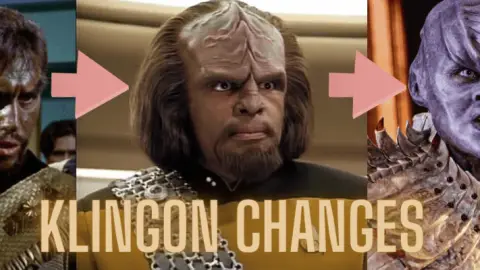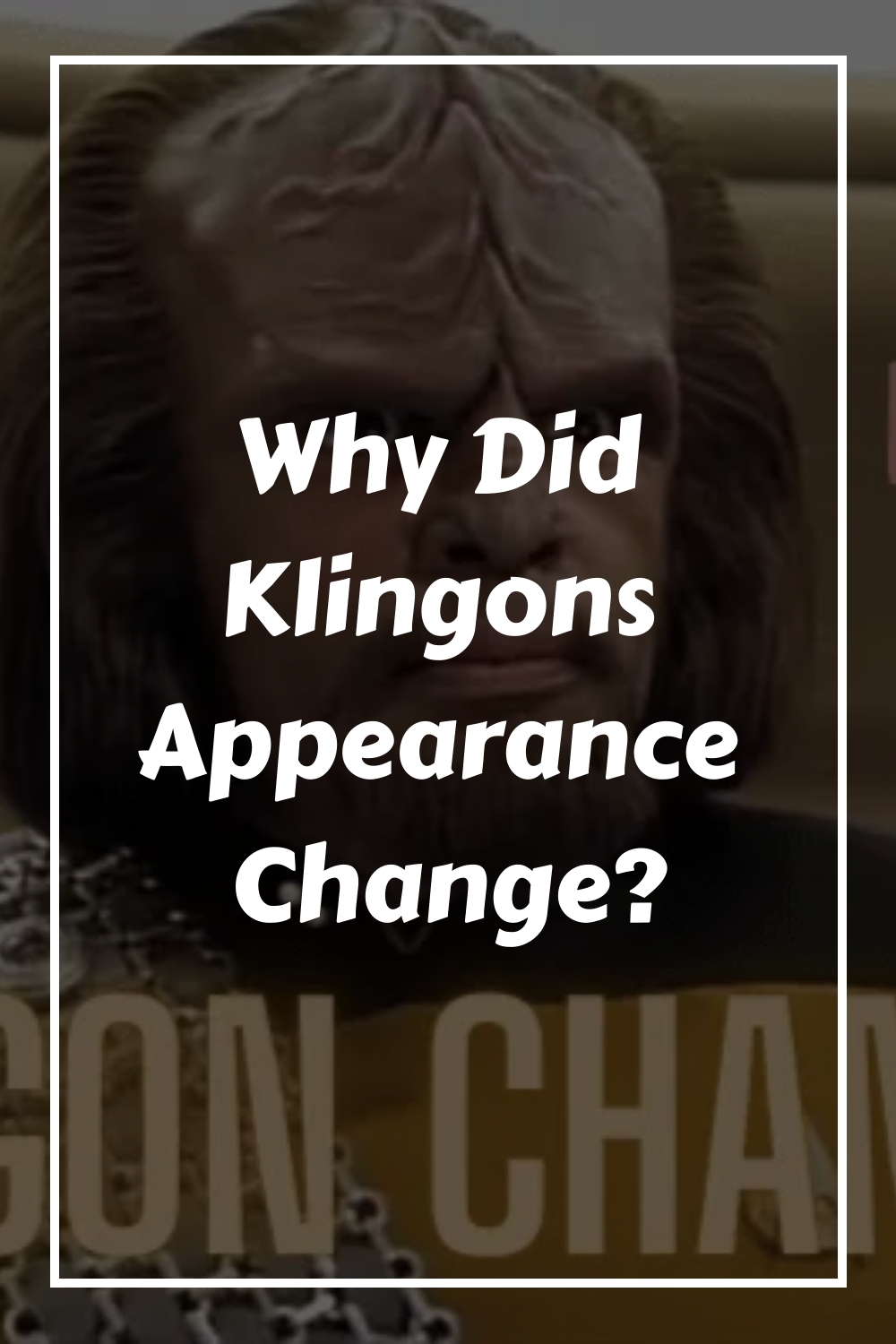Klingons have had a very interesting history in their appearance and uniforms throughout the centuries. They went from looking almost human to slight cranial ridges in the middle of their foreheads to full ridges like Worf on the Next Generation or the Discovery Klingons’ very different look. How did they go from looking almost human to looking completely animalistic?
Klingons took an Augment drug that took away their cranial ridges and made them look human. Sometime during the 22nd century, the drug’s designed to give a race super abilities. They took this to become greater warriors, but it had some unintended side effects and made them weaker, not stronger.
If you’ve always been curious as to why the Klingons have very different looks throughout several series, you’re not alone. Keep reading to find the full explanation.
The Appearance of the Klingons in The Original Series
On the Original Series (TOS), the Klingons looked mostly human, with flat foreheads and the same physical size as humans. They might have had bushier eyebrows than humans, and their skin color was a light brown or bronze, but other than that, they resembled humans in many ways.
Not only did they look more like humans, but they also acted very humanly in some ways, including how weak they were. They didn’t have the same physical strength as other Klingons in other series did, nor did they have the same fighting style that later or previous Klingons had. The one thing they had that matched later Klingons was the “die with honor” warrior mindset. However, that wasn’t advertised that often in TOS.
While the true answer is that Star Trek creators decided to change the look several times because they were unsure of how the Klingons should look, the storyline is that the Klingons were victims of a drug they took in the 22nd century that stripped away their physical strength and facial ridges.
The Klingons on TOS were still hostile to humans and other Federation members, but they didn’t have the same habits or eating preferences that later, or earlier, Klingons had. This suggests that they were still under the drug’s influence several generations later.
In TOS, the Klingon Empire was kept mostly a secret from outsiders. No one knew about or even understood, Klingon history and their value system. The Klingons remained a mystery to Federation members, and since the flat forehead Klingons were all any outsiders knew of, no one could fathom that other types of Klingons were on their homeworld.
However, in the prequel to TOS, the Enterprise crew started learning about the Klingon culture and saw the Klingons’ original form. But since that was about 100 years earlier, no one in the Original Series timeline knew what Klingons were about.
Star Trek: Enterprise Klingons Had Forehead Ridges
The prequel to TOS, Star Trek: Enterprise, showed Klingons as they were on the Next Generation–cranial ridges, larger in stature, and stronger than the Klingons that lived a century later. They also had prominent front teeth that pushed their mouths forward somewhat, and their hair was very long. When they spoke, they spoke in long, drawn-out words that were supposed to imply power.
No human knew what the Klingons were, what they stood for, or how they conducted first contact situations. Therefore, when Jonathan Archer was given the task of returning the injured Klingon to Kronos on board the Enterprise, he was unprepared for the reception he got once on Kronos.
In later episodes with the Klingons, the Enterprise crew encountered part of the Klingon culture, including what they ate and how they lived. They also found out how stubborn and warrior-like they could be. While the Klingons in TOS were stubborn, they were not as stubborn as those in Star Trek: Enterprise.
The Next Generation Klingons Also Had Ridges
Star Trek fans were shocked to find that the Klingons had cranial ridges that took over their entire face, especially since the Klingons on TOS had flat foreheads and looked more human than Klingon. The new Klingons had longer hair, full cranial ridges, and were larger and stronger than the previous Klingons.
Klingons served in Starfleet in this new series to show how far the two races had come. But Klingons that served aboard a Starfleet ship needed to keep their hair either short or pulled back.
When the Motion Picture came out, Klingons had spikes down the middle of their foreheads, as well as more prominent teeth. They still had short hair but were beginning to look like the Klingons that first appeared on Star Trek: Enterprise.
In later Star Trek movies, the Klingons had more cranial spikes and ridges, and their hair was longer than before. They still didn’t have the full forehead ridges like in the Next Generation, but they were beginning to look more like they did before their mass infection.
As the makeup artists decided on what they wanted the Klingons to look like, the storyline was that they were finally starting to gain their characteristics back after several generations. But they still didn’t reach their original form.
Star Trek: Voyager Klingons Were Still the Same
Since Voyager took place at roughly the same time as The Next Generation and Deep Space Nine, the Klingons looked the same throughout the three series. The Voyager crew only had one Klingon, and she was a Klingon-Human hybrid, which suggested that after the Khitomer Accords, humans and Klingons began mating and having relationships.
B’Elanna Torres dropped out of Starfleet Academy because she was too argumentative and chaotic to stay and follow the rules. Once she left the Academy, she joined the Maquis because they offered her a place to fight and a cause to fight for. However, Starfleet decided that the Maquis were wrong about their methods and that they were criminals, so they tried stopping the rebellious faction.
Voyager was sent to capture a certain Maquis ship that was lost in the Badlands, a particularly dangerous part of space. Both ships were caught in some sort of energy beam that transported them to the far reaches of the Delta Quadrant. Soon after that incident, B’Elanna Torres became the Chief Engineer of Voyager, despite her volatile nature.
B’Elanna had some cranial ridges, but her Klingon side was less pronounced than full Klingons since she was half-human. She had a smaller stature than other Klingons, and she appeared mostly human. But her temper was still that of a full Klingon, which got her into trouble on Voyager once in a while, such as when she broke Lieutenant Carey’s nose in Engineering before being appointed to the Chief Engineer position.
While she was disciplined for her actions, Captain Janeway realized that she was very skilled and passionate about Engineering and chose her for that position.
Since Voyager was lost in the Delta Quadrant, they didn’t run into too many Klingons on their way home. However, the Doctor ran a family simulation, complete with a holo-wife and two holo-children. His son had Klingon friends, which looked like the Klingons of the Next Generation era.
Star Trek: Discovery Klingons Were Also Bald
Star Trek: Discovery showed their fans a new Klingon that defied any logic in their appearance. Discovery Klingons were bald, had different cranial ridges, and had spikes on the sides of their skulls. Remember that Discovery was set ten years before James Kirk took command of the Enterprise when Klingons appeared human-like.
Within the Discovery series, the Klingons’ baldness was explained. It seems that when Klingons were at war with another race, or when they had a civil war amongst the houses, they shaved their heads to be more war-like. When the hostilities ceased, they let their hair grow back.
But that doesn’t explain why they looked so much different than the Klingons Kirk and crew came across ten years later. One explanation that will be fully explained later in this article is that some Klingons were not affected by the new virus that swept through the Klingon Empire and killed millions of Klingons.
What Happened Between Enterprise and the Original Series?
Why did the Klingons all of a sudden look almost human in only 100 years? How is it that they lost their ridges, their power, and their warrior’s stature? Sometime in the 22nd century, the Klingons heard about humans creating genetically superior humans in the late 1990s. It was the same genetic engineering that created Khan and his people.
They learned about a ship carrying Augmented humans that had crashed near the Klingon homeworld. Because they thought that humans were working on the way to overpower the Klingons and conquer them, they raced to the crash site and took the Augmented embryos to glean the DNA from them.
Once their top scientists created a drug from the DNA samples, they tested it on a few willing subjects. The few volunteers that took this died agonizing deaths, even after they began showing enhanced characteristics. But it didn’t work as they planned, because they also showed human characteristics.
Almost immediately, the cranial ridges disappeared, they became weak, and they contracted a flu-like illness that killed many Klingons. And because this drug affected the DNA sequences, it became a virus that continued for many generations of those who took the drug.
The virus, known as the Levodian Flu, would have wiped out the entire race had it not been for the Klingons requesting help from Dr. Phlox on the Enterprise. Dr. Phlox managed to stop the virus from killing the Klingons, but he could not stop the humanizing effects of the virus.
The Klingon High Council were afraid that these flat-forehead Klingons would become outcasts to the Empire, so they were the ones relegated to the “front line” of space as captains and crews of the Klingon Defense Space Force. By doing this, the “outcasts” would be assured of their place in the Empire.
Why Were the Discovery Klingons Different Than the Original Series Klingons?
There were some Klingons who did not take the drug and were not affected by it, so they retained their original appearance as compared with others who did take the drug. In Kirk’s time, the Augmented Klingons were the descendants of those who took the drug in the 22nd century and survived the Levodian flu.
The Discovery Klingons were descendants of those who avoided the drug in the 22nd century. Their ancestors did not get the virus that wiped out several Klingons as a result of the drug and was part of the High Council and the leaders of the Klingon Empire.
Another theory is that the Klingons of the 1960s series wanted to infiltrate humans on Earth by looking human. Klingon-Human infusions would make it easier to take over the Federation. But, since their scientific abilities didn’t match their aspirations, this didn’t happen the way they intended.
The Augment Virus Has Its Beginnings With Khan
In the 1990s, a group of genetically engineered superhumans escaped from Earth, of which one of those members was Khan, the arch nemesis of Captain James Kirk. These genetically engineered humans were a result of the eugenics wars from that era. It was an attempt to improve the human race by selective breeding and alteration of the human genome.
Instead, it created humans with superior abilities and a god-like complex. They were arrogant, egotistical, and extremely ambitious, which was a flaw that could not be corrected no matter how much the scientists worked to do so. They even tried to correct it at birth, but it was unavoidable, so the project was scrapped.
The resulting humans sought world domination, but the other non-superior humans fought against them and killed many. However, about 80 of them escaped. Later, when one of the ships crashed near the Klingon homeworld, the Klingons took some of the Augmented embryos back to their world for the scientists to create superior warriors, as mentioned earlier.
Several Generations of Klingons Were Affected By Genetic Engineering
Because of the virus caused by genetic engineering, several generations of Klingons were affected. They were weaker than other Klingons, as it was passed to the new generation from the parents. For over 100 years, the mutation virus created Klingons on the same playing field as humans, making them easier to fight in many ways.
However, one advantage they had over Federation vessels was that they had a cloaking device that allowed them to sneak up on an enemy vessel. Once they were in striking position, they decloaked and fired. This is one of the few ways they were able to defeat their enemies. Physically, they were not superior to any other race, but they at least had that advantage when they were in their ships.
As the mutation virus lessened, Klingons became stronger like they used to be. Their cranial ridges began growing back, and their teeth became more pronounced. That means that their Klingon DNA was fighting back against the mutations. By the time the Klingons were members of the Federation, they were almost back to normal.
Klingons Began Their Return to Normal in the First Star Trek Movie
In the first Star Trek movie, the Klingons began returning to their normal. Klingons had spikes in the middle of their foreheads, and their teeth began coming back to normal size. It is possible that by this time, the Klingon DNA started to regenerate and revert to the original Klingon DNA. By the sixth Star Trek movie, the Klingons started regaining their cranial ridges and warrior-like power.
It appears that the virus mutations had a limited lifespan of a few generations and that the human-like qualities began dissipating by the time James Kirk became a Starfleet admiral.
Klingons Wanted to Be Powerful, and It Backfired
The reason the Klingons wanted the Augment drug, to begin with, is that they hoped to create a more powerful race of Klingons that would more easily conquer worlds with their enhanced warriors. But it backfired in a way they didn’t expect because it turned them almost human, which is exactly the opposite of what they were looking for when they developed the virus.
For many generations, the Klingons fought against their ancestors’ mistakes and ambition, making them weak and powerless somehow. By the time Praxis exploded, which took out its key energy facility, they had needed to ally with the Federation. Had the Klingons not tried to enhance their warriors, would they have aligned with the Federation?
Conclusion
The Klingons’ appearance changed several times throughout the Star Trek Franchise, causing fans to wonder why they changed so rapidly and dramatically. Makeup artists for the shows couldn’t make up their minds about how they wanted the Klingons to look, so they played with several variations.
However, a drawing from the 1970s revealed that the Klingons were a proud warrior race with cranial ridges, prominent teeth, and strong stature. The drawing looks very similar to the Discovery Klingons, but the makeup artists for each series and movie had different interpretations of what they were supposed to be. Because of this, they explained a virus.
Sources
- Memory Alpha: Khan Noonien Singh
- Memory Alpha: Eugenics Wars
- Memory Alpha: B’Elanna Torres
- Memory Alpha: Maquis
- Comic Book: Star Trek: Why Do the Klingons Look Different in Discovery?
- Memory Alpha: Klingon Augment Virus
- Games Radar: Here’s Why the Klingons Look Different in Star Trek Discovery
- Daily Dot: Here’s Why the Klingons Look Different in Star Trek: Discovery Season 2
- Ex Astris Scientia: The Klingon Forehead Problem




